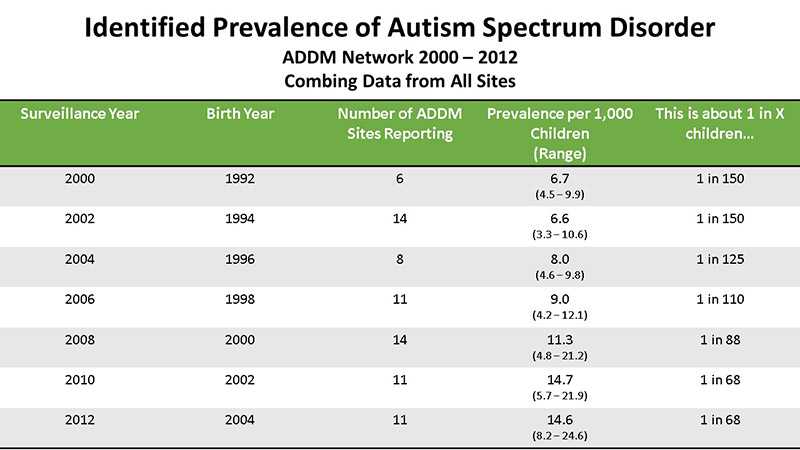Data & Statistics
Prevalence
- About 1 in 68 children has been identified with autism spectrum disorder (ASD) according to estimates from CDC’s Autism and Developmental Disabilities Monitoring (ADDM) Network. [Read summary] [Read article]
- ASD is reported to occur in all racial, ethnic, and socioeconomic groups. [Read summary] [Read article]
- ASD is about 4.5 times more common among boys (1 in 42) than among girls (1 in 189). [Read article]
- Studies in Asia, Europe, and North America have identified individuals with ASD with an average prevalence of between 1% and 2%. [Data table]
- About 1 in 6 children in the United States had a developmental disability in 2006-2008, ranging from mild disabilities such as speech and language impairments to serious developmental disabilities, such as intellectual disabilities, cerebral palsy, and autism. [Read summary]

Learn more about prevalence of ASD »
Learn more about the ADDM Network »
Risk Factors and Characteristics
- Studies have shown that among identical twins, if one child has ASD, then the other will be affected about 36-95% of the time. In non-identical twins, if one child has ASD, then the other is affected about 0-31% of the time. [1-4]
- Parents who have a child with ASD have a 2%–18% chance of having a second child who is also affected.[5,6]
- ASD tends to occur more often in people who have certain genetic or chromosomal conditions. About 10% of children with autism are also identified as having Down syndrome, fragile X syndrome, tuberous sclerosis, or other genetic and chromosomal disorders.[7-10]
- Almost half (about 44%) of children identified with ASD has average to above average intellectual ability. [Read article]
- Children born to older parents are at a higher risk for having ASD. [Read summary]
- A small percentage of children who are born prematurely or with low birth weight are at greater risk for having ASD. [Read summary]
- ASD commonly co-occurs with other developmental, psychiatric, neurologic, chromosomal, and genetic diagnoses. The co-occurrence of one or more non-ASD developmental diagnoses is 83%. The co-occurrence of one or more psychiatric diagnoses is 10%. [Read summary]
Diagnosis
- Research has shown that a diagnosis of autism at age 2 can be reliable, valid, and stable. [Read summary] [Read summary]
-
Even though ASD can be diagnosed as early as age 2 years, most children are not diagnosed with ASD until after age 4 years. The median age of first diagnosis by subtype is as follows. [Read article]
- Autistic disorder: 3 years, 10 months
- Pervasive developmental disorder-not otherwise specified (PDD-NOS): 4 years, 1 month
- Asperger disorder: 6 years, 2 months
- Studies have shown that parents of children with ASD notice a developmental problem before their child’s first birthday. Concerns about vision and hearing were more often reported in the first year, and differences in social, communication, and fine motor skills were evident from 6 months of age.[Read summary] [Read summary]
Economic Costs
-
The total costs per year for children with ASD in the United States were estimated to be between $11.5 billion – $60.9 billion (2011 US dollars). This significant economic burden represents a variety of direct and in-direct costs, from medical care to special education to lost parental productivity. [Read article] [Read article]
- Children and adolescents with ASD had average medical expenditures that exceeded those without ASD by $4,110–$6,200 per year. On average, medical expenditures for children and adolescents with ASD were 4.1–6.2 times greater than for those without ASD. Differences in median expenditures ranged from $2,240 to $3,360 per year with median expenditures 8.4–9.5 times greater. [Read article]
- In 2005, the average annual medical costs for Medicaid-enrolled children with ASD were $10,709 per child, which was about six times higher than costs for children without ASD ($1,812). [Read summary]
- In addition to medical costs, intensive behavioral interventions for children with ASD cost $40,000 to $60,000 per child per year.[11]
Highlighted Articles
Key Findings: Prevalence of Self-injurious Behaviors Among Children with Autism Spectrum Disorder
The Journal of Autism and Developmental Disorders has published a new study showing that nearly 28% of 8-year-old children with autism spectrum disorder (ASD) behave in ways that can lead to self-injury.
(Published: October 21, 2016)
Key Findings: Prevalence and Characteristics of Autism Spectrum Disorder Among 4-Year-Old Children
Data from a CDC pilot project, published in the Journal of Developmental and Behavioral Pediatrics, suggest that progress has been made in identifying children with autism spectrum disorder (ASD) at younger ages.
(Published December 9, 2015)
Key Findings: Autism symptoms among children enrolled in the Study to Explore Early Development
A new analysis looking at autism spectrum disorder (ASD) symptoms among young children enrolled in CDC’s Study to Explore Early Development (SEED).
(Published June 6, 2015)
Key Findings: The association between assisted reproductive technology and autism spectrum disorder
New studies on the relationship between ART and autism.
(Published March 20, 2015)
ADDM Network update
New CDC funding will expand knowledge about children with autism spectrum disorder.
(Published January 2, 2015)
Classifying autism in research studies
Using standardized diagnostic instruments to classify children with autism to help find causes of the disorder.
(Published October 27, 2014)
Key Findings
Unhealthy weight among adolescents with autism.
(Published March 17, 2014)
Risk Factors for Autism
Read key findings from new CDC research.
(Published: March 17, 2014)
Key Findings
Potential impact of DSM-5 criteria on autism spectrum disorder prevalence estimates.
(Published: January 22, 2014)
Why Act Early?
Intervention is likely to be more effective and less costly when it is provided earlier in life rather than later.
(Published: April 3, 2017)
Living with Autism: Anita’s Story
Read about one woman’s experience living with autism spectrum disorder (ASD).
(Published: March 28, 2017)
Developmental Milestones Matter!
Skills, such as taking a first step, smiling for the first time, and waving “bye-bye,” are called developmental milestones. From birth to 5 years, your child should reach milestones in how he or she plays, learns, speaks, acts and moves.
(Published: October 3, 2016)
New CDC Funding Will Expand Knowledge about Children with Autism Spectrum Disorder
Over the next five years, CDC will invest more than $27 million to carry out a new phase of the Study to Explore Early Development (SEED).
(Published: July 5, 2016)
New Data on Autism: Five Important Facts to Know
More can be done to ensure that children with ASD are evaluated as soon as possible after developmental concerns are recognized.
(Published: March 31, 2016)
Who Am I? A New Look At Autism
Read one mother’s perspective on autism spectrum disorder.
(Published: April 9, 2015)
Living with Autism
Learn more about the role of siblings through this family’s story.
(Published: April 6, 2015)
References
- Rosenberg RE, Law JK, Yenokyan G, McGready J, Kaufmann WE, Law PA. Characterisitics and concordance of autism spectrum disorders among 277 twin pairs. Arch Pediatr Adolesc Med. 2009; 163(10): 907-914.
- Hallmayer J, Cleveland S, Torres A, Phillips J, Cohen B, Torigoe T, Miller J, Fedele A, Collins J, Smith K, Lotspeich L, Croen LA, Ozonoff S, Lajonchere C, Grether JK, Risch N. Genetic heritability and shared environmental factors among twin pairs with autism. Arch Gen Psychiatry. 2011; 68(11): 1095-1102.
- Ronald A, Happe F, Bolton P, Butcher LM, Price TS, Wheelwright S, Baron-Cohen S, Plomin R. Genetic heterogeneity between the three components of the autism spectrum: A twin study. J. Am. Acad. Child Adolesc. Psychiatry. 2006; 45(6): 691-699.
- Taniai H, Nishiyama T, Miyahci T, Imaeda M, Sumi S. Genetic influences on the board spectrum of autism: Study of proband-ascertained twins. Am J Med Genet B Neuropsychiatr Genet. 2008; 147B(6): 844-849.
- Ozonoff S, Young GS, Carter A, Messinger D, Yirmiya N, Zwaigenbaum L, Bryson S, Carver LJ, Constantino JN, Dobkins K, Hutman T, Iverson JM, Landa R, Rogers SJ, Sigman M, Stone WL. Recurrence risk for autism spectrum disorders: A Baby Siblings Research Consortium study. Pediatrics. 2011; 128: e488-e495.
- Sumi S, Taniai H, Miyachi T, Tanemura M. Sibling risk of pervasive developmental disorder estimated by means of an epidemiologic survey in Nagoya, Japan. J Hum Genet. 2006; 51: 518-522.
- DiGuiseppi C, Hepburn S, Davis JM, Fidler DJ, Hartway S, Lee NR, Miller L, Ruttenber M, Robinson C. Screening for autism spectrum disorders in children with Down syndrome. J Dev Behav Pediatr. 2010; 31:181-191.
- Cohen D, Pichard N, Tordjman S, Baumann C, Burglen L, Excoffier E, Lazar G, Mazet P, Pinquier C, Verloes A, Heron D. Specific genetic disorders and autism: Clinical contribution towards their identification. J Autism Dev Disord. 2005; 35(1): 103-116.
- Hall SS, Lightbody AA, Reiss AL. Compulsive, self-injurious, and autistic behavior in children and adolescents with fragile X syndrome. Am J Ment Retard. 2008; 113(1): 44-53.
- Zecavati N, Spence SJ. Neurometabolic disorders and dysfunction in autism spectrum disorders. Curr Neurol Neurosci Rep. 2009; 9(2): 129-136.
- Amendah, D., Grosse, S.D., Peacock, G., & Mandell, D.S. (2011). The economic costs of autism: A review. In D. Amaral, D. Geschwind, & G. Dawson (Eds.), Autism spectrum disorders (pp. 1347-1360). Oxford: Oxford University Press.
Glossary
Prevalence is the number of people in a population that have a condition relative to all of the people in the population. Prevalence is typically shown as a percent (e.g. 1%) or a proportion (e.g. 1 in 100).
E-mail Your Friends
"Children with autism spectrum disorder are not being diagnosed as early as they could be. Learn the signs of autism and get help if you’re concerned."
Share on Facebook

“Many children with autism spectrum disorder (ASD) are not being identified as early as they could be. Early identification is the most powerful tool we have right now to make a difference in the lives of children with ASD.”
Share on Twitter
“Too many children w/ autism are not being identified as early as they could be. Earlier is better. #ActEarly”
- Page last reviewed: March 10, 2017
- Page last updated: July 11, 2016
- Content source:


 ShareCompartir
ShareCompartir